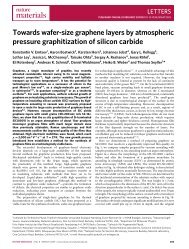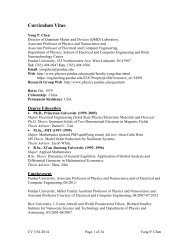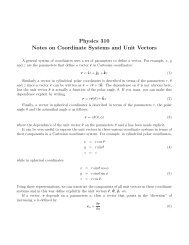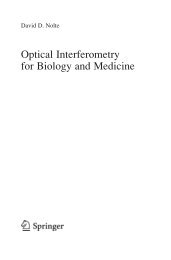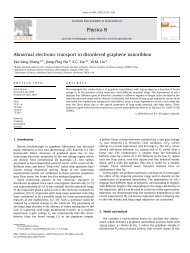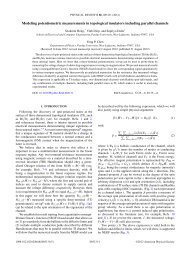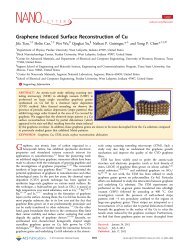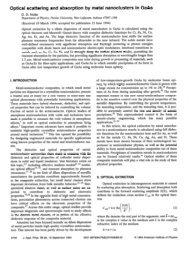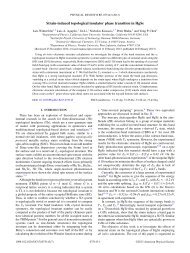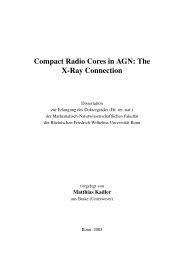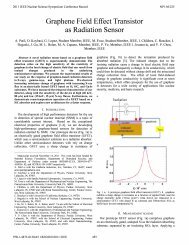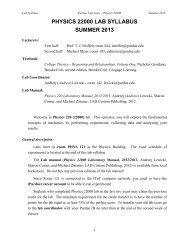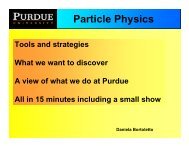1. A string is tied to a doorknob 0.79 m from the hinge as shown in ...
1. A string is tied to a doorknob 0.79 m from the hinge as shown in ...
1. A string is tied to a doorknob 0.79 m from the hinge as shown in ...
Create successful ePaper yourself
Turn your PDF publications into a flip-book with our unique Google optimized e-Paper software.
<strong>1.</strong> A <strong>str<strong>in</strong>g</strong> <strong>is</strong> <strong>tied</strong> <strong>to</strong> a <strong>doorknob</strong> <strong>0.79</strong> m <strong>from</strong> <strong>the</strong> <strong>h<strong>in</strong>ge</strong> <strong>as</strong> <strong>shown</strong> <strong>in</strong> <strong>the</strong> figure. At <strong>the</strong> <strong>in</strong>stant<br />
<strong>shown</strong>, <strong>the</strong> force applied <strong>to</strong> <strong>the</strong> <strong>str<strong>in</strong>g</strong> <strong>is</strong> 5.0 N. What <strong>is</strong> <strong>the</strong> <strong>to</strong>rque on <strong>the</strong> door?<br />
<strong>0.79</strong> m<br />
A) 3.3 N • m B) 2.2 N • m C) <strong>1.</strong>1 N • m D) 0.84 N • m E) 0.40 N • m<br />
2. Which one of <strong>the</strong> follow<strong>in</strong>g statements concern<strong>in</strong>g <strong>the</strong> moment of <strong>in</strong>ertia I <strong>is</strong> false?<br />
A) I may be expressed <strong>in</strong> units of kg • m 2.<br />
B) I depends on <strong>the</strong> angular acceleration of <strong>the</strong> object <strong>as</strong> it rotates.<br />
C) I depends on <strong>the</strong> location of <strong>the</strong> rotation ax<strong>is</strong> relative <strong>to</strong> <strong>the</strong> particles that make up <strong>the</strong><br />
object.<br />
D) I depends on <strong>the</strong> orientation of <strong>the</strong> rotation ax<strong>is</strong> relative <strong>to</strong> <strong>the</strong> particles that make up<br />
<strong>the</strong> object.<br />
E) Of <strong>the</strong> particles that make up an object, <strong>the</strong> particle with <strong>the</strong> smallest m<strong>as</strong>s may<br />
contribute <strong>the</strong> greatest amount <strong>to</strong> I.<br />
3. The two dams are identical with <strong>the</strong> exception that <strong>the</strong> water reservoir beh<strong>in</strong>d dam A<br />
extends twice <strong>the</strong> horizontal d<strong>is</strong>tance beh<strong>in</strong>d it <strong>as</strong> that of dam B. Which one of <strong>the</strong><br />
follow<strong>in</strong>g statements regard<strong>in</strong>g <strong>the</strong>se dams <strong>is</strong> correct?<br />
A) The force exerted by <strong>the</strong> water on dam A <strong>is</strong> greater than that on dam B.<br />
B) The force exerted by <strong>the</strong> water on dam B <strong>is</strong> greater than that on dam A.<br />
C) Dam A <strong>is</strong> more likely <strong>to</strong> collapse than dam B if <strong>the</strong> water level r<strong>is</strong>es.<br />
D) Dam B <strong>is</strong> more likely <strong>to</strong> collapse than dam A if <strong>the</strong> water level r<strong>is</strong>es.<br />
E) The horizontal d<strong>is</strong>tance of <strong>the</strong> water beh<strong>in</strong>d <strong>the</strong> two dams does not determ<strong>in</strong>e <strong>the</strong><br />
force on <strong>the</strong>m.<br />
4. A column of water of height 70.0 cm supports a column of an unknown liquid <strong>as</strong><br />
suggested <strong>in</strong> <strong>the</strong> figure (not drawn <strong>to</strong> scale). Assume that both liquids are at rest and that<br />
<strong>the</strong> density of water <strong>is</strong> <strong>1.</strong>0× 10 3 kg/m 3. Determ<strong>in</strong>e <strong>the</strong> density of <strong>the</strong> unknown liquid.<br />
A) 3.9 × 10 2 kg/m 3 D) 3.3 × 10 3 kg/m 3<br />
Page 1
B) <strong>1.</strong>2 × 103 kg/m 3 E) 3.9 × 10 3 kg/m 3<br />
C) 2.6 × 10 3 kg/m 3<br />
5. At a certa<strong>in</strong> temperature, a simple pendulum h<strong>as</strong> a period of <strong>1.</strong>500 seconds. The support<br />
wire <strong>is</strong> made of silver and h<strong>as</strong> a coefficient of l<strong>in</strong>ear <strong>the</strong>rmal expansion of <strong>1.</strong>90 × 10 -5/C°.<br />
How much must <strong>the</strong> temperature be <strong>in</strong>cre<strong>as</strong>ed <strong>to</strong> <strong>in</strong>cre<strong>as</strong>e <strong>the</strong> period <strong>to</strong> <strong>1.</strong>506 seconds?<br />
A) 118 C° B) 221 C° C) 422 C° D) 316 C° E) 528 C°<br />
6. Complete <strong>the</strong> follow<strong>in</strong>g statement: The term heat most accurately describes<br />
A) <strong>the</strong> <strong>in</strong>ternal energy of an object.<br />
B) a me<strong>as</strong>ure of how hot an object <strong>is</strong>.<br />
C) <strong>the</strong> absolute temperature of an object.<br />
D) <strong>the</strong> molecular motion <strong>in</strong>side of an object.<br />
E) <strong>the</strong> flow of energy due <strong>to</strong> a temperature difference.<br />
Use <strong>the</strong> follow<strong>in</strong>g <strong>to</strong> answer question 7:<br />
Heat <strong>is</strong> added <strong>to</strong> a <strong>1.</strong>0-kg solid sample of a material at −200 °C. The figure shows <strong>the</strong><br />
temperature of <strong>the</strong> material <strong>as</strong> a function of <strong>the</strong> heat added.<br />
7. Which one of <strong>the</strong> follow<strong>in</strong>g statements concern<strong>in</strong>g th<strong>is</strong> substance <strong>is</strong> true?<br />
A) It boils at 300 °C.<br />
B) It melts at −200 °C.<br />
C) It <strong>is</strong> a liquid at 200 °C.<br />
D) It can coex<strong>is</strong>t <strong>as</strong> a solid and a liquid at −50 °C.<br />
Page 2
E) It can ex<strong>is</strong>t <strong>as</strong> a solid, liquid, and g<strong>as</strong> at 150 °C.<br />
8. Two cyl<strong>in</strong>drical steel rods A and B have radii of 0.02 m and 0.04 m, respectively. It <strong>is</strong><br />
found that <strong>the</strong> two steel rods conduct <strong>the</strong> same amount of heat per unit time for <strong>the</strong> same<br />
temperature differences between <strong>the</strong>ir two ends. What <strong>is</strong> <strong>the</strong> ratio of <strong>the</strong> lengths of <strong>the</strong><br />
rods, L A/L B?<br />
A) 0.25 B) 0.50 C) <strong>1.</strong>00 D) 2.00 E) 4.00<br />
9. An ideal g<strong>as</strong> <strong>is</strong> conta<strong>in</strong>ed <strong>in</strong> a vessel with a moveable p<strong>is</strong><strong>to</strong>n. Initially, <strong>the</strong> g<strong>as</strong> h<strong>as</strong> a<br />
volume of 0.018 m 3, an absolute pressure of <strong>1.</strong>5 atm, and a temperature of 30 °C. The<br />
pressure <strong>is</strong> 0.75 atm when <strong>the</strong> volume of <strong>the</strong> conta<strong>in</strong>er <strong>is</strong> decre<strong>as</strong>ed <strong>to</strong> 0.009 m 3. What <strong>is</strong><br />
<strong>the</strong> f<strong>in</strong>al temperature of <strong>the</strong> g<strong>as</strong>?<br />
A) 76 K B) 98 K C) 170 K D) 240 K E) 300 K<br />
10. A 200.00-kg object <strong>is</strong> attached via an ideal pulley system <strong>to</strong> paddle wheels that are<br />
submerged <strong>in</strong> 0.480 kg of water at 20.0 C° <strong>in</strong> an <strong>in</strong>sulated conta<strong>in</strong>er <strong>as</strong> <strong>shown</strong> <strong>in</strong> <strong>the</strong><br />
draw<strong>in</strong>g. Then, <strong>the</strong> object fallls through a d<strong>is</strong>tance of 5.00 m caus<strong>in</strong>g <strong>the</strong> paddle wheel <strong>to</strong><br />
turn. Assum<strong>in</strong>g all of <strong>the</strong> mechanical energy lost by <strong>the</strong> fall<strong>in</strong>g object goes <strong>in</strong><strong>to</strong> <strong>the</strong><br />
water, determ<strong>in</strong>e <strong>the</strong> f<strong>in</strong>al temperature of <strong>the</strong> water.<br />
A) 4.90 °C B) 20.5 °C C) 24.9 °C D) 40.4 °C E) 98.2 °C<br />
1<strong>1.</strong> Which one of <strong>the</strong> follow<strong>in</strong>g situations <strong>is</strong> a direct application of <strong>the</strong> Zeroth Law of<br />
Thermodynamics?<br />
A) Block A h<strong>as</strong> twice <strong>the</strong> temperature of block B before <strong>the</strong>y are brought <strong>in</strong><strong>to</strong> contact.<br />
Upon contact, heat flows <strong>from</strong> block A <strong>to</strong> block B.<br />
B) A sample of g<strong>as</strong> with<strong>in</strong> a cyl<strong>in</strong>der with a p<strong>is</strong><strong>to</strong>n <strong>is</strong> held at constant temperature and<br />
pressure while it <strong>is</strong> allowed <strong>to</strong> expand. Dur<strong>in</strong>g th<strong>is</strong> process, <strong>the</strong> g<strong>as</strong> absorbs heat <strong>from</strong><br />
its surround<strong>in</strong>gs.<br />
C) The mo<strong>to</strong>r of a refrigera<strong>to</strong>r uses electric energy <strong>to</strong> remove heat <strong>from</strong> <strong>in</strong>side <strong>the</strong><br />
refrigera<strong>to</strong>r and transfer it <strong>to</strong> <strong>the</strong> room.<br />
D) A physic<strong>is</strong>t removes energy <strong>from</strong> a system <strong>in</strong> her labora<strong>to</strong>ry until it reaches a<br />
temperature of 3 × 10 −10 K, a temperature very close <strong>to</strong> (but still greater than)<br />
absolute zero.<br />
Page 3
E) A <strong>the</strong>rmometer <strong>is</strong> calibrated by plac<strong>in</strong>g it <strong>in</strong> an ice water bath with<strong>in</strong> an adiabatic<br />
conta<strong>in</strong>er until <strong>the</strong> <strong>the</strong>rmometer <strong>is</strong> <strong>in</strong> <strong>the</strong>rmal equilibrium with <strong>the</strong> ice water.<br />
12. Enclosed beneath <strong>the</strong> moveable p<strong>is</strong><strong>to</strong>n <strong>in</strong> <strong>the</strong> figure <strong>is</strong> 4.8 moles of a mona<strong>to</strong>mic ideal<br />
g<strong>as</strong>. The g<strong>as</strong> performs work on <strong>the</strong> p<strong>is</strong><strong>to</strong>n <strong>as</strong> 2300 J of heat are added <strong>from</strong> <strong>the</strong><br />
surround<strong>in</strong>gs. Dur<strong>in</strong>g <strong>the</strong> process, <strong>the</strong> temperature of <strong>the</strong> g<strong>as</strong> decre<strong>as</strong>es by 45 K. How<br />
much work does <strong>the</strong> g<strong>as</strong> perform?<br />
A) 5000 J B) 3200 J C) 1400 J D) 600 J E) 400 J<br />
13. A <strong>the</strong>rmally <strong>is</strong>olated sample of an ideal g<strong>as</strong> at a fixed temperature <strong>is</strong> conf<strong>in</strong>ed <strong>to</strong> one half<br />
of a conta<strong>in</strong>er by an impermeable membrane. The o<strong>the</strong>r half of <strong>the</strong> conta<strong>in</strong>er <strong>is</strong> evacuated.<br />
The membrane <strong>is</strong> <strong>the</strong>n pierced and <strong>the</strong> g<strong>as</strong> <strong>is</strong> allowed <strong>to</strong> expand freely and <strong>to</strong> double its<br />
volume <strong>as</strong> <strong>shown</strong>. Which one of <strong>the</strong> follow<strong>in</strong>g statements <strong>is</strong> true concern<strong>in</strong>g th<strong>is</strong><br />
situation?<br />
A) The process <strong>is</strong> reversible.<br />
B) Th<strong>is</strong> <strong>is</strong> an <strong>is</strong>o<strong>the</strong>rmal process.<br />
C) The entropy of <strong>the</strong> g<strong>as</strong> decre<strong>as</strong>es.<br />
D) The <strong>in</strong>ternal energy of <strong>the</strong> g<strong>as</strong> must decre<strong>as</strong>e.<br />
E) The temperature of <strong>the</strong> g<strong>as</strong> decre<strong>as</strong>es <strong>to</strong> one-half of its orig<strong>in</strong>al value.<br />
14. A fixed amount of ideal g<strong>as</strong> <strong>is</strong> compressed adiabatically. Which entry <strong>in</strong> <strong>the</strong> table below<br />
correctly depicts <strong>the</strong> sign of <strong>the</strong> work done, <strong>the</strong> change <strong>in</strong> <strong>the</strong> <strong>in</strong>ternal energy, and <strong>the</strong><br />
heat exchanged with <strong>the</strong> environment?<br />
work done change <strong>in</strong> <strong>in</strong>ternal energy heat exchanged<br />
A) positive negative zero<br />
B) negative zero positive<br />
C) negative negative zero<br />
D) positive positive zero<br />
E) negative positive zero<br />
Page 4
15. A steel wire of m<strong>as</strong>s 0.400 kg and length 0.640 m supports a 102-kg block. The wire <strong>is</strong><br />
struck exactly at its midpo<strong>in</strong>t caus<strong>in</strong>g a small d<strong>is</strong>placement. How long does it take <strong>the</strong><br />
peak of th<strong>is</strong> d<strong>is</strong>placement <strong>to</strong> reach <strong>the</strong> <strong>to</strong>p of <strong>the</strong> wire?<br />
A) 2.00 × 10 -3 s D) 8.00 × 10 -3 s<br />
B) 4.00 × 10 -3 s E) <strong>1.</strong>60 × 10 -2 s<br />
C) 6.00 × 10 -3 s<br />
16. A transverse periodic wave described by <strong>the</strong> expression<br />
(where y and x are <strong>in</strong> meters and t <strong>is</strong> <strong>in</strong> seconds) <strong>is</strong> establ<strong>is</strong>hed on a <strong>str<strong>in</strong>g</strong>. Which one of<br />
<strong>the</strong> follow<strong>in</strong>g statements concern<strong>in</strong>g th<strong>is</strong> wave <strong>is</strong> false?<br />
A) The wave <strong>is</strong> travel<strong>in</strong>g <strong>in</strong> <strong>the</strong> negative x direction.<br />
B) The amplitude <strong>is</strong> <strong>1.</strong>0 m.<br />
C) The frequency of <strong>the</strong> wave <strong>is</strong> 0.10 Hz.<br />
D) The wavelength of th<strong>is</strong> wave <strong>is</strong> 2.0 m.<br />
E) The wave travels with speed 5.0 m/s.<br />
17. Two travel<strong>in</strong>g pulses on a rope move <strong>to</strong>ward each o<strong>the</strong>r at a speed of <strong>1.</strong>0 m/s. The waves<br />
have <strong>the</strong> same amplitude. The draw<strong>in</strong>g shows <strong>the</strong> position of <strong>the</strong> waves at time t = 0 s.<br />
Which one of <strong>the</strong> follow<strong>in</strong>g draw<strong>in</strong>gs depicts <strong>the</strong> waves on <strong>the</strong> rope at t = 2.0 s?<br />
A)<br />
B)<br />
Page 5
C)<br />
D)<br />
E)<br />
18. Water waves approach an aperture. The result<strong>in</strong>g patterns are <strong>shown</strong> for two different<br />
c<strong>as</strong>es, A and B, <strong>in</strong> which <strong>the</strong> wavelength and aperture size are varied.<br />
Which one of <strong>the</strong> follow<strong>in</strong>g statements concern<strong>in</strong>g <strong>the</strong>se c<strong>as</strong>es <strong>is</strong> true?<br />
A) Nei<strong>the</strong>r figure shows diffraction. In both c<strong>as</strong>es, <strong>the</strong> wavelength <strong>is</strong> much smaller than<br />
<strong>the</strong> aperture.<br />
B) Diffraction occurs <strong>in</strong> A, but not <strong>in</strong> B because <strong>the</strong> wavelength <strong>in</strong> A <strong>is</strong> much smaller<br />
than <strong>the</strong> aperture.<br />
C) Diffraction occurs <strong>in</strong> B, but not <strong>in</strong> A because <strong>the</strong> wavelength <strong>in</strong> B <strong>is</strong> much smaller<br />
than <strong>the</strong> aperture.<br />
D) Both figures show diffraction. In both c<strong>as</strong>es, <strong>the</strong> wavelengths are approximately <strong>the</strong><br />
same size <strong>as</strong> <strong>the</strong> aperture.<br />
E) Diffraction occurs <strong>in</strong> B, but not <strong>in</strong> A because <strong>the</strong> wavelength <strong>in</strong> B <strong>is</strong> approximately<br />
<strong>the</strong> same size <strong>as</strong> <strong>the</strong> aperture.<br />
19. A 25-coil spr<strong>in</strong>g with a spr<strong>in</strong>g constant of 350 N/m <strong>is</strong> cut <strong>in</strong><strong>to</strong> five equal spr<strong>in</strong>gs with five<br />
coils each. What <strong>is</strong> <strong>the</strong> spr<strong>in</strong>g constant of each of <strong>the</strong> 5-coil spr<strong>in</strong>gs?<br />
A) 14 N/m B) 70 N/m C) 350 N/m D) 700 N/m E) 1750 N/m<br />
Page 6
20. A vertical block-spr<strong>in</strong>g system on earth h<strong>as</strong> a period of 6.0 s. What <strong>is</strong> <strong>the</strong> period of th<strong>is</strong><br />
same system on <strong>the</strong> moon where <strong>the</strong> acceleration due <strong>to</strong> gravity <strong>is</strong> roughly 1/6 that of<br />
earth?<br />
A) <strong>1.</strong>0 s B) 2.4 s C) 6.0 s D) 15 s E) 36 s<br />
Page 7
Answer Key -- F<strong>in</strong>alExam<br />
<strong>1.</strong> A<br />
2. B<br />
3. E<br />
4. C<br />
5. C<br />
6. E<br />
7. D<br />
8. A<br />
9. A<br />
10. C<br />
1<strong>1.</strong> E<br />
12. A<br />
13. B<br />
14. E<br />
15. D<br />
16. E<br />
17. A<br />
18. E<br />
19. E<br />
20. C<br />
Page 8



